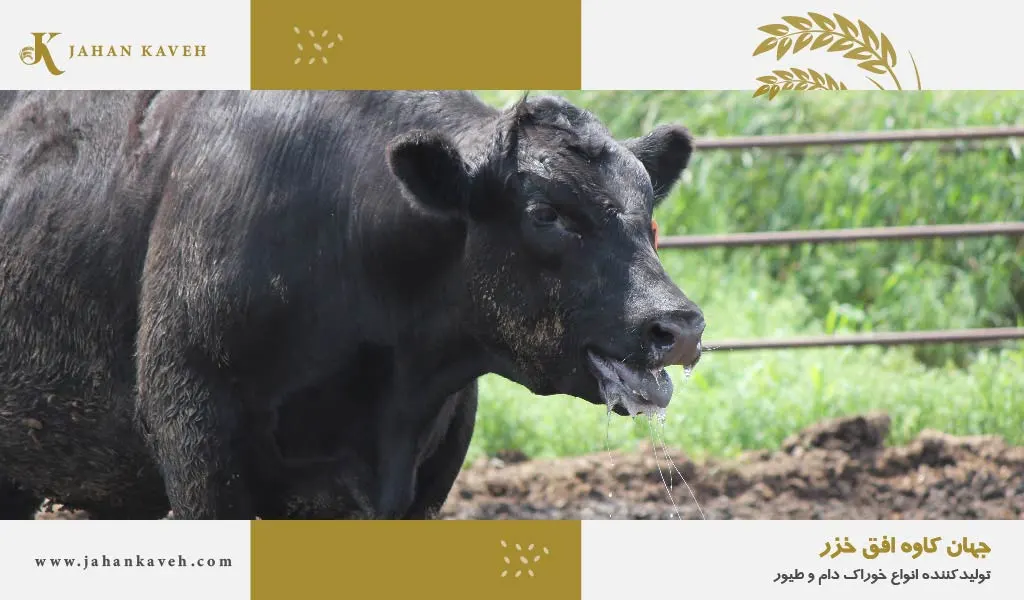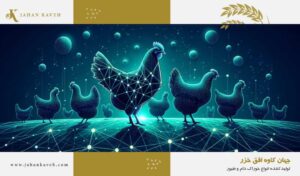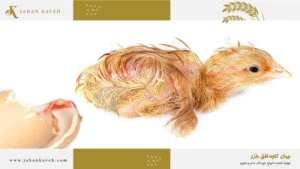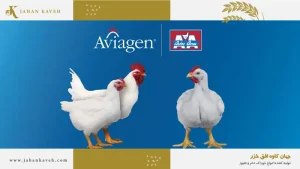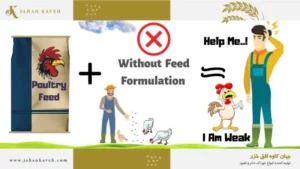Heat Stress in Livestock
Heat stress in livestock occurs when the ambient temperature exceeds the animal’s ability to regulate its internal body temperature. This phenomenon occurs in both industrial and traditional livestock farming systems and can have numerous negative consequences. At temperatures above the animal’s body temperature, heat stress can have detrimental effects on weight gain, milk production, fertility, welfare, and overall farm productivity.
The responsibility for animal welfare and protection from heat stress lies with farm owners and workers. This care includes planning and implementing measures such as:
- Providing adequate shade: Shade should be designed and implemented to provide sufficient shade for all animals throughout the day.
- Ensuring proper ventilation: Proper ventilation helps air circulate inside the barn and lowers the ambient temperature.
- Providing continuous access to cool, clean water: Constant access to cool, clean water is essential to keep animals hydrated.
- Checking for signs of heat stress: such as increased respiration, sweating, lethargy, and decreased appetite, throughout the day is crucial.
By implementing simple preventive measures, heat stress in livestock can be minimized, and its detrimental effects on animal health, production, and farm productivity can be prevented.
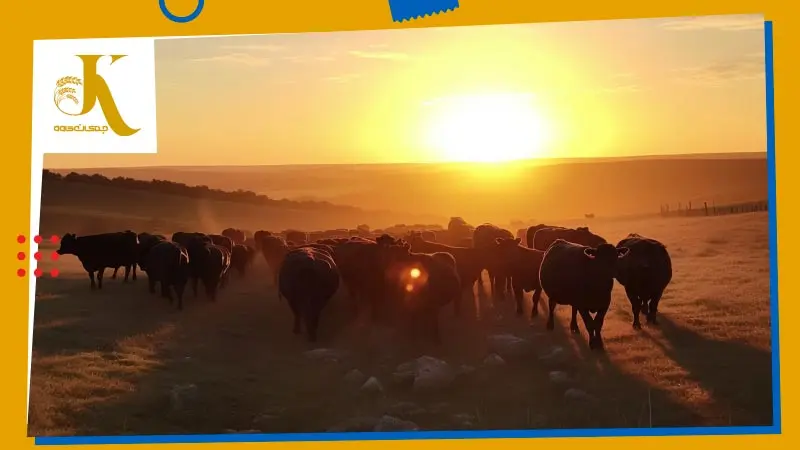
Cow Heat Stress: Signs You Need to Know
Scorching heat can be extremely dangerous to the health and well-being of cows. Heat stress in cows occurs when the ambient temperature exceeds the animal’s ability to regulate its internal body temperature, and it can have numerous negative consequences. Awareness of the signs of heat stress in cows can help you take timely action and prevent more serious problems. Here are some of the signs of heat stress in cows:
- Lethargy and listlessness: One of the first signs of heat stress in cows is lethargy and decreased activity. Heat-affected cows are less inclined to move around and tend to lie or stand in the shade more often. Cows under heat stress may appear listless, apathetic, and dull. They withdraw from their usual activities and become secluded. The animal tries to cool itself down by seeking shade, standing in water, or reducing its activity level.
- Hair loss (cause of hair loss in cows): The cause of hair loss in cows and sheep is not directly related to heat. However, any stress, such as heat stress, calving stress, and relocation, can cause hair loss in animals.
- Increased respiratory rate (panting): As body temperature rises, cows breathe faster to cool down. Rapid and continuous breathing is a prominent sign of heat stress in cows.
- Increased water intake: In an effort to compensate for sweating and maintain body hydration, heat-affected cows drink more water. A sudden increase in water intake can be a sign of heat stress.
- Loss of appetite: Excessive heat can reduce cows’ desire and appetite to eat. Loss of appetite in cows can lead to reduced growth rates.
- Decreased milk production: Dairy cows may experience a drop in milk production during periods of heat stress due to reduced appetite.
- Reduced fertility and reproduction: Heat stress can have negative effects on reproductive performance in cows, leading to decreased fertility rates.
- Increased salivation and nasal discharge: The heat can cause a lot of stress in cows, especially when it reaches high or extreme levels. This stress can lead to symptoms such as foaming at the mouth and runny nose in the animal.
- Increased susceptibility to diseases: Heat stress weakens cows’ immune systems, making them more susceptible to diseases and health problems.
- Fainting: In severe cases of heat stress, a cow may experience fever, tremors, seizures, and even fainting. This condition is very dangerous and requires immediate veterinary intervention.
Stages of Heat Stress in Livestock
According to the USDA Agricultural Research Service, the following are the signs of heat stress:
- Stage 1: Increased respiratory rate, restlessness, increased time spent standing
- Stage 2: Increased respiratory rate, slight drooling, restlessness, increased time spent standing
- Stage 3: Increased respiratory rate, excessive drooling or foaming, restlessness, increased time spent standing, animals may group together
- Stage 4: Increased respiratory rate, open-mouth breathing, possible drooling, increased time spent standing, animals may group together
- Stage 5: High-pitched breathing with heaving of the flanks, open-mouth breathing with tongue protruding, possible drooling, restlessness, increased time spent standing
- Stage 6: Open-mouth breathing with tongue protruding, labored breathing and decreased respiratory rate, excessive flank movement when breathing, head down, no saliva discharge required at this stage, animal may separate from the herd.
Signs of heat stress in cattle can worsen quickly. Observing any of these signs indicates the need for immediate action to cool and hydrate the cattle. In advanced stages of heat stress, the animal may require immediate veterinary attention.
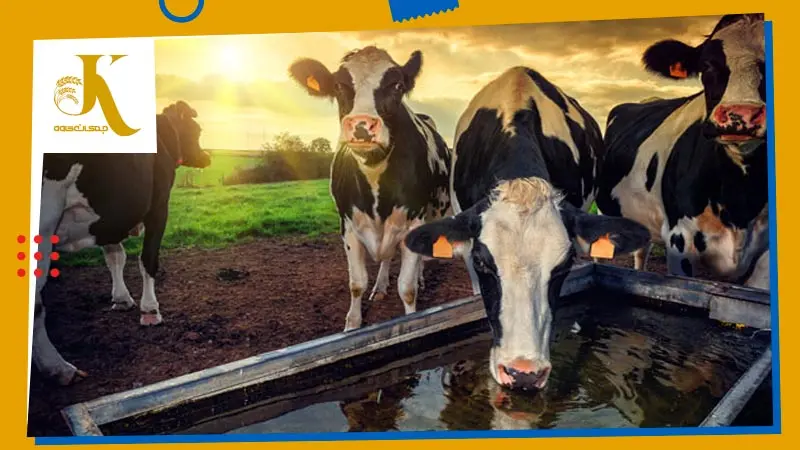
Heat Stress Management in Cattle | Livestock Heat Stress Treatment
Heat can be the silent killer of your livestock! If you observe signs of heat stress in your animals, it is crucial to act quickly and correctly to cool them down and lower their body temperature. Here are the steps you should take to treat heat stress in livestock:
- Immediate Transfer to a Cool Location: The first step is to quickly move the animal to a cool, shaded area. If the animal is unable to move, carefully transport it to a cool location with the help of others.
- Provide Cool, Clean Water: Access to cool, clean water is essential to keep the animal’s body hydrated. Encourage the animal to drink water by pouring a small amount of cool water on its nose or mouth.
- Cool the Animal’s Body: Spraying cool water on the animal’s body, especially the head, neck, and back, will help cool them down quickly. Using damp, cool towels to cool the animal’s body is also effective.
- Increase Ventilation: Increase air circulation in the animal’s holding area using fans or any other means available. If possible, move the animals to an open area with good ventilation.
- Use Vitamins and Minerals: Supplementation with cattle vitamins and minerals throughout the year can help reduce the effects of heat stress on reproduction.
- Contact a Veterinarian: If the animal’s condition does not improve or if severe symptoms develop, contact a veterinarian immediately. The veterinarian can examine the animal thoroughly and provide the necessary treatment.
Additional Tips:
Always monitor your cattle for unusual behavior and movements. Problems often arise during stressful events. Pay attention to signs and problems.There are several stages of heat stress with specific signs. Once the first signs of heat stress are observed, minimize stress immediately. Early intervention is key to survival, especially providing intervention in the evening when cattle try to dissipate the heat of the day.
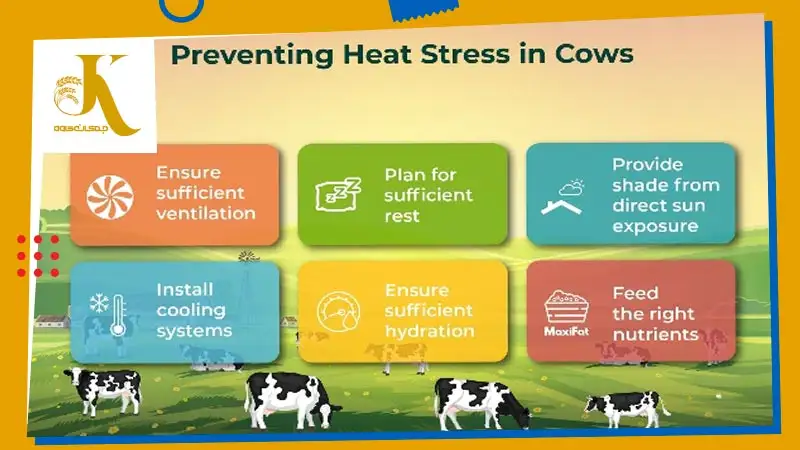
Heat Stress Prevention in Livestock
Extreme heat can be very detrimental to the health and production of livestock. Heat stress in livestock occurs when the ambient temperature exceeds the animal’s ability to regulate its internal body temperature, and it can have numerous negative consequences. By implementing appropriate preventive measures, you can prevent heat stress from occurring in your livestock and jeopardizing their health and production. Here are some simple tips to keep your livestock cool. With these methods, you can be sure that your cattle are comfortable:
- Access to cool, clean water: Constant access to cool, clean water is essential to keep animals hydrated. Use multiple water troughs at different heights to make it easy for animals to reach the water. Clean and disinfect water troughs regularly to prevent water contamination.
- Adequate shade: Providing adequate shade in the animal’s holding area is the first step in preventing heat stress. Shade should be designed and implemented to provide sufficient shade for all animals throughout the day. Use tall, dense shade structures to prevent direct sunlight from reaching the animals’ bodies.
- Proper ventilation: Proper ventilation of the barn and animal holding area helps air circulate and lowers the ambient temperature. Use fans, coolers, or any other means available to increase ventilation. If possible, use air conditioning systems to maintain a comfortable ambient temperature.
- Proper nutrition: During hot days, feed animals diets with lower fiber and higher energy content. Use high-quality, palatable feed to maintain animal appetite. Do not neglect to add the necessary minerals and vitamins to the animals’ diets.
- Breed selection: Selecting heat-tolerant livestock breeds can significantly help prevent heat stress. Breeds like Brahman and Balochi are better suited for rearing in hot climates due to their high heat resistance.
- Activity time management: Schedule strenuous activities for livestock, such as milking, shearing, and transportation, during the cooler hours of the day. Avoid strenuous activities during hot hours, especially during peak heat.
- Monitoring and tracking animals: Regularly monitor the condition of animals for signs of heat stress, such as increased respiration, sweating, lethargy, and loss of appetite. If you notice any signs, take the necessary steps to cool and hydrate the animals.
- Consult a veterinarian: For expert advice on preventing heat stress in livestock, consult an experienced veterinarian. The veterinarian can provide appropriate and effective recommendations based on the region’s climate and the type of livestock.
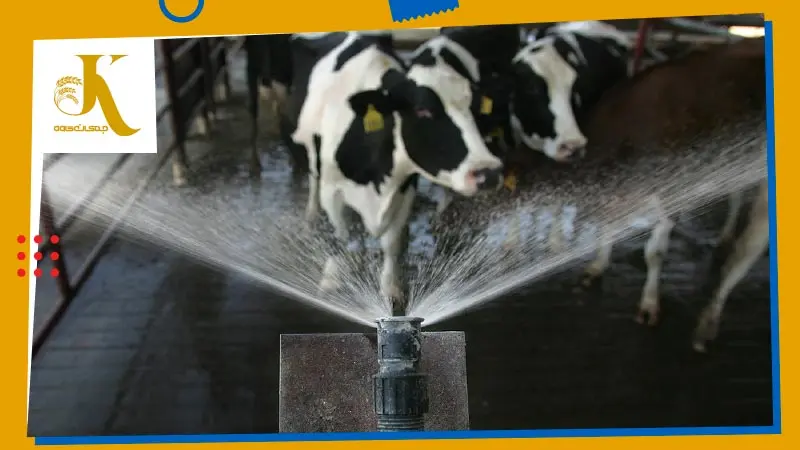
Providing Water for Livestock During Hot Seasons to Prevent Heat Stress in Cattle
During the hot summer months, providing sufficient, cool, and clean water for livestock plays a crucial role in preventing heat stress and maintaining their health and productivity. Heat stress can have detrimental effects on weight gain, milk production, fertility, and the overall well-being of cattle. By carefully planning and implementing preventive measures, you can avoid problems caused by water scarcity during hot seasons. Key points for providing adequate water for livestock in hot seasons include:
- Water Containers:
- Size and Accessibility: Water containers should be large enough to accommodate all animals simultaneously. Adjust the number of containers based on the herd size and place additional containers in different areas of the farm as the number of animals increases.
- Sturdiness of Water Troughs: Water containers should be sturdy and firmly secured to prevent them from tipping over. Use durable materials that can withstand impact and damage.
- Desired Water Temperature and Health for Livestock in Hot Seasons:
- Cool Water: To keep water cool, you can use large concrete tanks or shade covers for water containers. You can also utilize cooling systems like water chillers. Covering water lines with grass in fence rows can also help keep water cooler. Cattle prefer water temperatures between 40°F (4.4°C) and 65°F (18.3°C). Water intake decreases when the water temperature exceeds 80°F (26.6°C).
- Cleanliness: Water containers should be cleaned and disinfected regularly to prevent the growth of algae, bacteria, and contaminants.
- Water Flow and Watering System in Summer for Livestock:
- Continuous Access: Ensure that water is available in containers at all times. You can use automatic waterers to provide fresh water to animals at any time.
- Pipe Capacity: Water pipes should have sufficient diameter to deliver the required water volume for livestock during peak demand periods in hot weather.
- Placement of Water Troughs on the Farm:
- Familiarity for Cattle: Water trough locations should be easy for cattle to find and access quickly. Avoid placing water troughs in busy or noisy areas.
- Short Distances: Animals should not have to travel long distances to find water. If paddocks are changed, especially in large pastures, make sure cattle are familiar with the location of water tanks, as pasture height may hide water troughs from their view (especially younger and smaller animals).
Article: Optimize Winter Feeding for Cattle
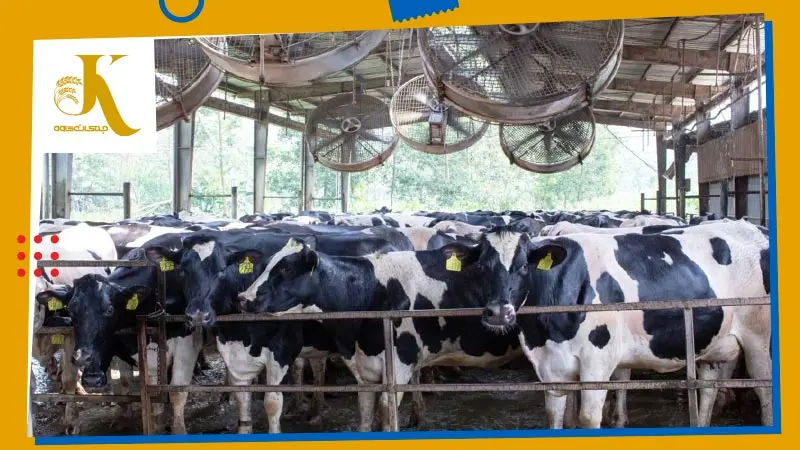
Types of Shelters for Heat Protection
Providing shade during hot days is crucial for the health and well-being of livestock. These shelters are especially important for very young, old, weak, and sick animals. The best type of shelter is a structure that protects animals from intense heat and sunburn from sunlight. They also have a cooling effect due to air circulation. Types of shelters for livestock include:
- Constructed Shelters: Aluminum or galvanized steel is an ideal material for shelter roofs. These materials reflect sunlight well. For open areas, shade can also be easily created using shade cloth or tarps.
- Trees: Trees in pastures and fields can also provide good shelter. Trees have a cooling effect due to the absorption of heat by the leaves. Shade can be easily created by providing access to pastures with trees. If the number of shaded pasture hectares is limited and the herd grazes at moderate temperatures during the day, this can lead to heat stress in cattle.
To answer the question of what is the best type of shelter for livestock, the answer is:
The best type of shelter is a structure that protects animals from sunlight and intense heat. They also have a cooling effect due to air circulation.
Features of a Good Shelter for Livestock
When choosing a suitable shelter for your livestock, consider the following factors:
- Adequate Space for Livestock: Ensure that the number of shelters is proportionate to the herd size. If there are too few shelters, overcrowding under the shelters can lead to suffocation of the animals. It is even better if the shelters are large enough for the animals to lie down under.
- Sufficient Shade for Livestock: The shelter should provide enough shade for all animals throughout the day.
- Good Air Circulation: Ensure that shelters are located in areas with good air circulation.
- Proper Ventilation in Livestock Housing: If livestock are housed in a barn or enclosed structure, proper fans or ventilation systems should be used to circulate air inside the space. Otherwise, access to an outdoor pen or pasture with shade should be provided. If proper ventilation is not available, using sprinklers will worsen the situation as there is no good airflow. Always have a backup plan in case of power or water system failures.
- Easy Access to Shade for Livestock: The shade should be located in a suitable location and easily accessible to the animals so they can seek shelter under it without difficulty.
- Durability of Shelter or Shade for Cattle: The shelter should be constructed from high-quality, durable materials that can withstand various weather conditions. Maintain shelters in good condition to ensure they are safe and effective.
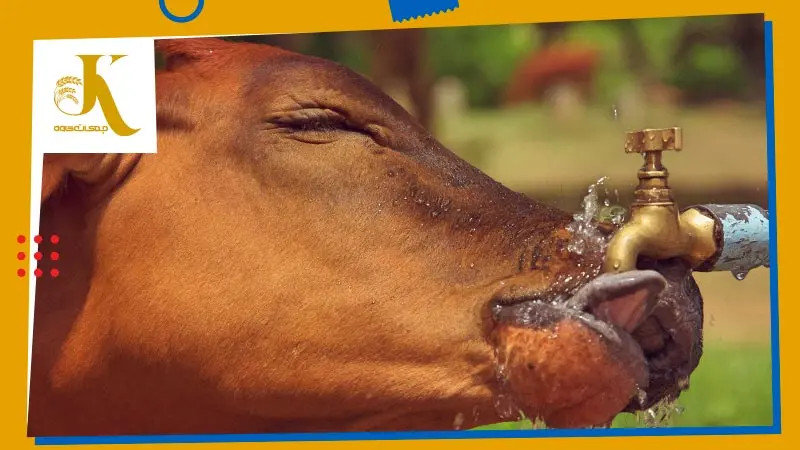
Summer Heat and Livestock Care: Key Points
The summer season can pose significant challenges to the health and well-being of livestock. By implementing appropriate measures, these issues and potential threats to animal health and productivity can be prevented. Here are essential considerations for caring for livestock during hot summer days:
- Minimize Animal Contact: On hot days, refrain from touching or handling animals as much as possible. This can increase their body heat. If examination or necessary procedures are required, try to do so in the cooler morning or late afternoon hours.
- Cool Milking Times: Schedule milking during the coolest times of the day, such as the evening.
- Bathing Schedule: Avoid bathing or washing animals with cool water during hot daylight hours if possible. The best time for this is early morning or late afternoon.
- Monitor Heat Stress Signs: Regularly check for signs of heat stress in animals, such as increased respiration, sweating, lethargy, and loss of appetite. If any warning signs are observed, take necessary steps to cool down and hydrate the animals.
By adhering to these guidelines and closely monitoring animal health, livestock producers can effectively manage the challenges of hot weather and maintain the well-being and productivity of their animals.
Article: Ticks and parasites in livestock
Livestock Transport During Hot Summer Months
Transporting livestock during hot days requires careful planning and execution to prevent heat stress and associated issues. Weather conditions should be anticipated, and if transport is essential, a well-structured travel plan must be in place. When transporting cattle during warm seasons, adhere to the following guidelines:
- Thorough Planning: Plan and determine the route, transportation time, shaded areas, and water access points along the journey.
- Choose the Right Time: Schedule transport during the coolest hours of the day, such as early morning or late afternoon.
- Suitable Vehicle: Utilize an appropriate vehicle with adequate ventilation and shade for transporting the animals.
- Minimize Stops: Keep stops to a minimum to prevent heat buildup during halts. If stops are necessary, park the vehicle in the shade and perpendicular to the wind direction to minimize heat generation during the pause.
- Emergency Preparedness: Plan for contingencies such as vehicle breakdowns or sudden weather changes.
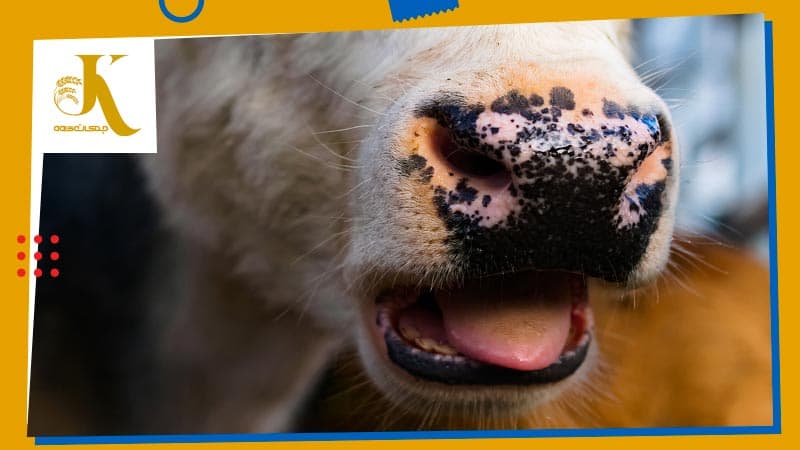
Livestock at Higher Risk of Heat Stress
Heat stress poses a significant challenge to the health and well-being of livestock during hot seasons. Understanding the factors that increase the risk of heat stress in animals can help implement necessary preventive measures to protect them. Livestock more susceptible to heat stress include:
- Young Livestock: Due to their underdeveloped nervous and bodily systems, they have a reduced ability to regulate their body temperature against heat.
- Dark-Colored Animals: Darker hair or skin color absorbs more heat, leading to an increase in body temperature.
- Sick or Weak Livestock: Their compromised immune systems make them more vulnerable to heat stress. Animals with a history of respiratory issues have less capacity to dissipate heat through respiration due to breathing difficulties.
Heat stress tolerance can also vary between species, for instance:
- Sheep: Sheep with recently shorn wool are more prone to heat and heat stress due to the lack of wool insulation. Wool acts as an insulator, protecting sheep from sunburn and heat stress.
- Cattle, Alpacas, and Llamas: Generally, these animals have lower heat tolerance compared to sheep and goats and are more susceptible to heat stress.
- Production Type Differences: Dairy cows are more prone to heat stress due to increased metabolic heat production during lactation.
- Breed Differences: Some breeds are genetically more heat-sensitive.
- Production Level: In dairy cows, those with higher milk production are more affected by heat and heat stress due to their more active metabolism compared to lower-yielding cows.
Therefore, the type of housing and its conditions in industrial livestock production are crucial for achieving the highest production rates. By understanding these factors and implementing appropriate management practices, livestock producers can effectively mitigate the risks associated with heat stress and safeguard the health and productivity of their animals.
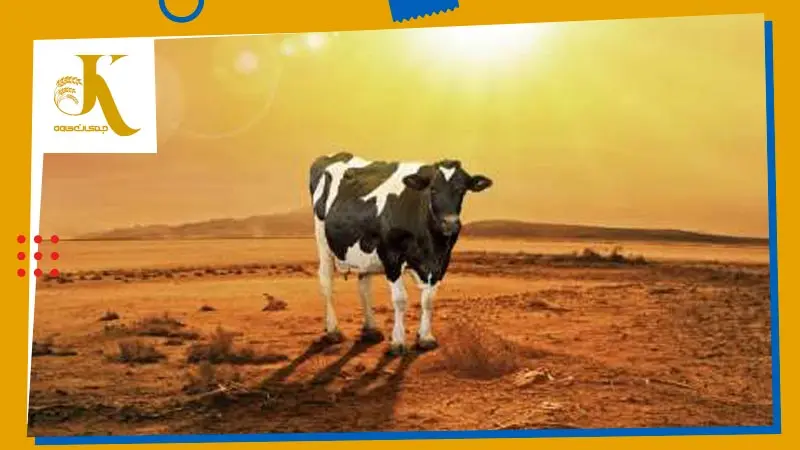
Heat Stress in Cattle
Cattle experience heat stress at lower temperatures compared to humans. To maintain their ideal body temperature, they rely on various mechanisms such as sweating, rapid breathing, and seeking shade. Cattle prefer temperatures below 20°C (68°F), although the breed also plays a role in this tolerance. Cattle’s heat tolerance is largely dependent on their breed. For instance, Holstein herds experience a decline in reproduction when temperatures exceed 21°C (70°F), while Jersey cows can tolerate up to 25°C (77°F). Holsteins also have lower heat tolerance compared to Jersey cows. British breeds of sheep and cattle have lower tolerance than Merino or tropical beef breeds. Additionally,lighter cattle are more prone to heat stress than heavier ones. Other factors that influence heat stress in cattle include:
- Body Weight: Lighter cattle, due to their higher surface area-to-volume ratio, are more susceptible to heat stress compared to heavier ones.
- Coat Color: Darker-coated cattle absorb more heat, making them more prone to heat stress.
- Production Status: Lactating cows, due to increased metabolic heat production, are more susceptible to heat stress than non-lactating cows.
- Health Status: Sick or weak cows have a compromised immune system, making them more vulnerable to heat stress.
- Presence of Flies: Flies can cause cattle to bunch together, which further increases their heat load. Minimizing fly breeding areas and using insecticides to reduce fly populations before heat stress periods is crucial.
It is important to note that cattle can adapt to warmer temperatures if the transition is gradual. During periods of increasing heat stress, it’s essential to closely monitor cattle to determine if additional strategies are necessary to mitigate the effects. As heat stress intensifies, cattle may exhibit various signs.
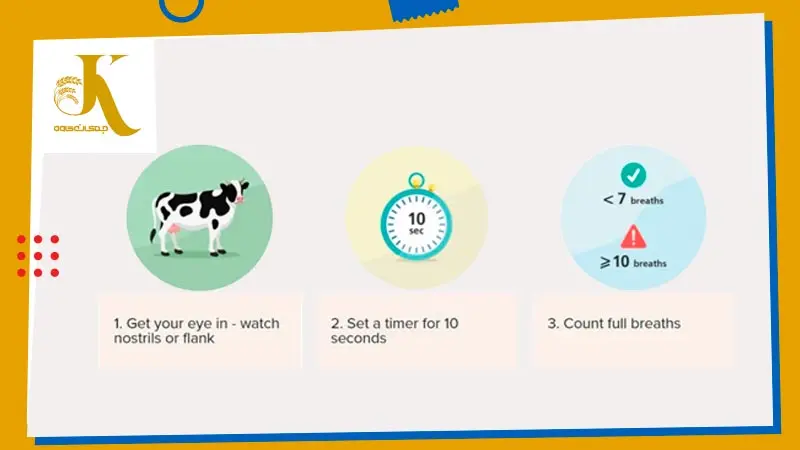
Monitoring Cattle Respiration Rates for Heat Stress in Hot Seasons
The first sign of heat stress in cattle is an increased respiratory rate. To assess heat stress in a herd, it is ideal to randomly select ten cows on a hot summer afternoon. Random selection typically involves choosing black cows with high milk production or fatter cows. These animals are more prone to heat stress due to their increased heat absorption. To check the respiration rate of the animals, follow these steps:
- Close Observation: Carefully observe the cow’s nostrils or flanks to count their breathing movements.
- Time Measurement: Use a timer to measure 10 seconds.
- Respiration Count: During the 10 seconds, accurately count the number of complete breaths the cow takes.
After performing these steps, it is crucial to interpret the cow’s respiration rate. Remember that if the respiration rate in 10 seconds is less than 7, the conditions are favorable. However, for values equal to or greater than 10, the conditions are dangerous and unfavorable.Additionally, the cow’s respiration rate per minute is as follows:
- Less than 90 breaths per minute: Favorable conditions
- 90 to 110 breaths per minute: Warning
- Over 130 breaths per minute: Danger
- Over 130 breaths per minute: Emergency
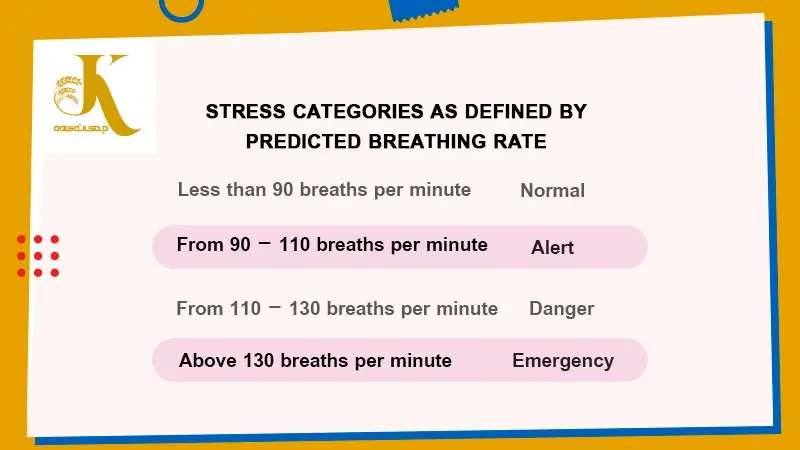
Why Cattle Get Hot Quickly
Like all living organisms, cattle have an ideal temperature range where they feel comfortable and their immune systems and organs function properly. This ideal temperature range for cattle is between 4°C (39°F) and 20°C (68°F). Here are the reasons why cattle get hot quickly:
- High Metabolism: Cattle produce a lot of heat due to their high energy consumption for digestion and milk production. This heat production makes it more difficult for them to maintain their ideal body temperature in warmer environments.
- Heat Absorption from the Environment: Cattle, like any other organism, absorb heat from their surroundings. In hot seasons, this poses an additional challenge to maintaining their body temperature. Certain factors intensify the heat in a cow’s body:
- High Humidity: High humidity in the environment hinders sweat evaporation and respiration as cooling mechanisms, increasing the risk of heat stress.
- Lack of Wind: The absence of wind makes it difficult for air to circulate and cool the cow’s body.
- High Nighttime Temperatures: If nighttime temperatures are also high, cows do not have a chance to cool down during the night, increasing the risk of heat stress the following day.
In response, the cow’s body employs mechanisms to reduce body temperature:
- Sweating: Cattle sweat to release excess heat. As sweat evaporates from the body’s surface, their body temperature cools down.
- Rapid Breathing: Increased respiratory rate leads to greater water evaporation through the lungs, aiding in body cooling.
- Reduced Feed Intake: In hot conditions, cattle tend to eat less food to reduce heat production in their rumen. This can lead to decreased milk production in dairy cows.
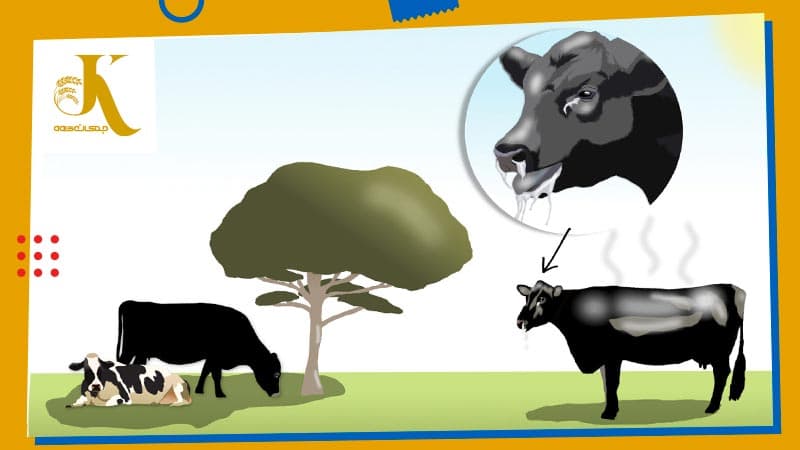
Heat Stress in Dairy Cows: Mitigation Strategies and Consequences
The summer season can pose a significant challenge to the health, productivity, and fertility of dairy cows. Heat stress, also known as thermal stress, occurs when the ambient temperature exceeds the cow’s ability to regulate its internal body temperature. To effectively prevent heat stress in dairy cows, implementing the following strategies is crucial:
- Provide Ample Shade: Ensure sufficient shade is available for cows to escape direct sunlight. This helps reduce heat absorption and promotes comfort.
- Ensure Access to Clean, Cool Water: Grant cows continuous access to fresh, cool water to stay hydrated and maintain their body’s cooling mechanisms.
- Adjust Milking and Feeding Times: Schedule milking and feeding during the coolest hours of the day, such as early morning or late afternoon. This minimizes heat exposure during these activities.
Failure to adequately address heat stress in dairy cows can lead to detrimental consequences, including:
- Reduced Milk Production: Heat stress disrupts the cow’s metabolism, diverting energy away from milk production towards cooling efforts. Additionally, heat-induced reduced feed intake further contributes to decreased milk yield.
- Increased Abortion and Reduced Fertility: Elevated uterine temperature due to heat stress hinders blood flow, leading to reduced fertility, increased abortion rates, and ovarian cysts.
- Shortened Gestation Periods and Premature Calving: Excessive heat can trigger premature calving, resulting in weak and premature calves. This also increases the risk of newborn calf mortality.
- Impaired Reproductive Function in Bulls: Heat stress can delay postpartum uterine involution in cows, prolonging the interval between calving cycles.
By implementing effective heat stress prevention strategies and monitoring for signs of heat stress, dairy producers can safeguard the health, productivity, and reproductive efficiency of their cows, ensuring optimal performance throughout the year.
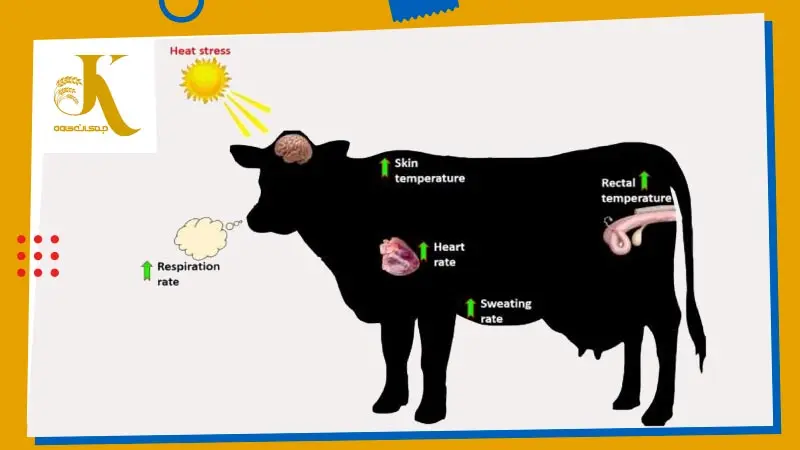
Heat Stress in Beef Cattle: Impacts and Mitigation Strategies
Heat stress poses a significant concern for beef producers, particularly during the sweltering summer months. While the consequences of heat stress in beef cattle may not be immediately apparent, they can have far-reaching effects on their health, weight gain, and overall productivity. It is crucial to maintain an ideal body condition score (BCS) for beef cattle, typically between 5 and 6. The detrimental effects of heat stress on beef cattle include:
- Energy Diversion for Thermoregulation: Under heat stress, the body diverts energy from growth and weight gain towards cooling mechanisms to maintain homeostasis. This energy expenditure comes at the expense of muscle development and overall productivity.
- Reduced Feed Intake: During hot periods, cattle tend to eat less, leading to a decline in nutrient and energy intake essential for growth and weight gain. This further exacerbates the negative impacts of heat stress.
- Weight Loss: The combination of increased energy expenditure for cooling and reduced feed intake results in weight loss and impaired growth efficiency in beef cattle.
- Health Issues: Heat stress can manifest in various health problems, including lethargy, anorexia, increased respiration, excessive sweating, and muscle weakness.
Sunlight, particularly in the shorter wavelengths, can significantly elevate a cow’s body temperature. This is particularly hazardous for dark-coated cattle that absorb more heat. Additionally, beef cattle with heavier weights face a greater challenge from heat stress. The reasons why heavier cattle are more susceptible to heat include:
- Increased Fat Deposition: Fat deposits in heavier cattle act as insulation, hindering the dissipation of body heat.
- Larger Body Surface Area: Heavier cattle have a larger body surface area compared to lighter ones, meaning they absorb more heat from sunlight and their surroundings.
• Reduced Mobility: Due to their heavier weight, heavier cattle have reduced mobility, which in turn diminishes their ability to cool down through sweating and respiration.

